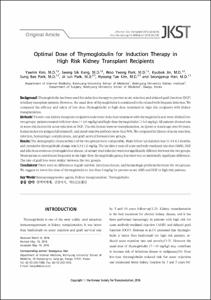KUMEL Repository
1. Journal Papers (연구논문)
1. School of Medicine (의과대학)
Dept. of Internal Medicine (내과학)
Optimal Dose of Thymoglobulin for Induction Therapy in High Risk Kidney Transplant Recipients
- Alternative Author(s)
- Kang, Seong Sik; Park, Woo Young; Park, Sung Bae; Jin, Kyu Bok; Park, Ui Jun; Kim, Hyoung Tae; Han, Seung Yeup
- Journal Title
- 대한이식학회지
- ISSN
- 1598-1711
- Issued Date
- 2016
- Abstract
- Background: Thymoglobulin has been used for induction therapy to prevent acute rejection and delayed graft function (DGF)
in kidney transplant patients. However, the usual dose of thymoglobulin is considered to be related with frequent infection. We
compared the efficacy and safety of low-dose thymoglobulin to high-dose treatment in high risk recipients with kidney
transplantation.
Methods: Twenty-one kidney transplant recipients underwent induction treatment with thymoglobulin and were divided into
two groups: patients treated with low-dose (<6.0 mg/kg) and high-dose thymoglobulin (≥6.0 mg/kg). All patients showed one
or more risk factors for acute rejection or DGF. The risk factors were re-transplantation, recipient or donor age over 60 years,
human leukocyte antigen full mismatch, and panel-reactive antibody more than 50%. We compared incidence of acute rejection,
infection, hematologic complications, and graft survival between two groups.
Results: The demographic characteristics of the two groups were comparable. Mean follow-up duration was 11.9±4.3 months,
and cumulative thymoglobulin dosage was 6.3±1.6 mg/kg. The incidence rates of acute antibody-mediated rejection (AMR), DGF
and infectious events as cytomegalovirus disease, or urinary tract infection were not significantly different between the two groups.
Neutropenia occurred more frequently in the high-dose thymoglobulin group, but there was no statistically significant difference.
The rate of graft loss were similar between the two groups.
Conclusions: There were no differences in graft survival, infectious disease, and hematologic problems between the two groups.
We suggest to lower the dose of thymoglobulin to less than 6 mg/kg for prevent acute AMR and DGF in high risk patients.
- Publisher
- School of Medicine
- Citation
- Yaerim Kim et al. (2016). Optimal Dose of Thymoglobulin for Induction Therapy in High Risk Kidney Transplant Recipients. 대한이식학회지, 30(2), 82–85. doi: 10.4285/jkstn.2016.30.2.82
- Type
- Article
- ISSN
- 1598-1711
- 파일 목록
-
-
Download
 oak-2016-0168.pdf
기타 데이터 / 180.43 kB / Adobe PDF
oak-2016-0168.pdf
기타 데이터 / 180.43 kB / Adobe PDF
-
Items in Repository are protected by copyright, with all rights reserved, unless otherwise indicated.